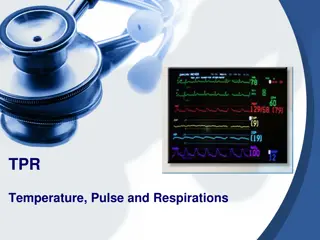Temperature, Heat, and Expansion - Chapter 14 & 15 Recap
This text explains the concepts and relationships between temperature, heat, energy, and expansion. It discusses different temperature scales and the idea of thermal equilibrium. It also covers the difference between temperature and heat, as well as how heat is measured.
10 views • 28 slides
Radar Attenuation Tomography for Mapping Englacial Temperature Distributions
Radar Attenuation Tomography is used to map the temperature distributions within the ice sheet by analyzing the radio waves' attenuation properties. This study focuses on the Eastern Shear Margin of Thwaites Glacier, where fast-moving ice meets slower ice, impacting ice rheology influenced by temper
4 views • 18 slides
Understanding Temperature Distribution and Differences in Heat
Explore the distribution of temperature across latitudes and elevations, and learn about the difference between heat and temperature. From horizontal to vertical variations, discover how factors like latitude influence temperature distribution patterns globally. Gain insights into the fundamental co
9 views • 19 slides
Exploring Weather through Infrared Temperature Detection
Studying everyday weather using infrared temperature detection from the environment can help in understanding the relationship between temperature variations of different objects and weather conditions. This activity involves creating hypotheses and testing them using an infrared temperature sensor.
0 views • 20 slides
Understanding Temperature Independent Paramagnetism (TIP) and Anomalous Magnetic Moments in Metal Ions
Temperature Independent Paramagnetism (TIP) explains the second-order Zeeman effect's magnetic susceptibility unaffected by temperature changes. Anomalous magnetic moments are observed in metal ions, deviating from predicted values based on electron angular momenta. The interaction of spin states in
1 views • 15 slides
Understanding Temperature and Color Relationship in Candle Flames
Explore the relationship between temperature and color in candle flames through the three zones model. By conducting experiments using a thermocouple sensor, investigate how the color gradient in a flame correlates with its temperature variations. Learn about the structure of a candle flame, the inf
1 views • 21 slides
Exploring Temperature Patterns on Earth: The Sun's Effect on Climate
Discover the fascinating relationship between the sun's effect on climate and temperature patterns on Earth at different latitudes and times of the year. This lesson delves into how temperatures vary with latitude from the equator, examining data for January and July to identify patterns and underst
4 views • 15 slides
Principles of Supremacy, Direct Effect, Indirect Effect, and State Liability in European Legislation
This lecture delves into the essential principles of supremacy, direct effect, indirect effect, and state liability within European Legislation, focusing on the foundational aspects and development by the CJEU. It emphasizes the concept of EU law's absolute supremacy over national laws for the achie
2 views • 33 slides
Exploring Temperature: Facts, Measurement, and Scales
Understanding temperature is crucial in daily life. This content delves into the definition, measurement, and scales of temperature, highlighting key facts such as body temperature, freezing and boiling points of water, and extreme temperatures like those found in lightning and the sun. Discover how
1 views • 9 slides
Understanding Temperature Effects on Donor and Acceptor Ionization in Semiconductors
Temperature plays a crucial role in the ionization of donor and acceptor atoms in semiconductors. In N-type semiconductors, the Fermi level lies below the conduction band, while in P-type semiconductors it lies above the valence band, with the position depending on temperature and impurity atoms. Do
1 views • 13 slides
Understanding Body Temperature Regulation
Explore how the body maintains its internal temperature through mechanisms such as correcting overheating and overcooling, the role of thermoreceptors, and voluntary responses that help control temperature. Discover the importance of regulating internal body temperature for optimal enzyme-catalyzed
2 views • 18 slides
Understanding Temperature and Friction in Metal Forming Processes
Metal forming processes are influenced by temperature and friction. At different temperature ranges, such as cold, warm, and hot working, the mechanical properties and forming behaviors of metals vary significantly. Cold working offers advantages like higher accuracy and strength, while warm working
0 views • 7 slides
Understanding Gas Laws: Boyle's, Charles', Gay-Lussac's, and Avogadro's Laws
Gas laws such as Boyle's Law, Charles' Law, Gay-Lussac's Law, and Avogadro's Law govern the behavior of gases under different conditions. Boyle's Law relates pressure and volume at constant temperature, Charles' Law relates volume and temperature at constant pressure, Gay-Lussac's Law relates pressu
1 views • 19 slides
Understanding Heat and Temperature in Thermodynamics
Thermal energy transfer, heat, and temperature play crucial roles in determining the behavior of systems in terms of kinetic energy and molecular motion. The zeroth law of thermodynamics establishes the relationship between heat and temperature. Heat transfer leads to changes in the average kinetic
8 views • 8 slides
Understanding the In-Combination Effect Test and De Minimis Effects in Environmental Assessments
This content discusses the complexities of the in-combination effect test and de minimis effects in environmental impact assessments. It covers when the in-combination effect assessment is needed, the legislation surrounding such assessments, and the concept of no appreciable effect as a threshold f
0 views • 21 slides
Understanding Temperature Measurement in Plant Growth
Exploring the measurement of maximum and minimum air temperature, its significance in analyzing trends and variations, and how temperature impacts plant growth stages. The optimal temperature ranges for different plant species and the importance of maximum and minimum temperature recordings using sp
0 views • 20 slides
New Measurements of the EMC Effect at 12 GeV - Frontiers and Careers Workshop
In this workshop, new measurements of the EMC Effect at 12 GeV were discussed, shedding light on one of the biggest unsolved mysteries in nuclear physics. The discovery, prediction, and quantification of the EMC Effect were explored, raising questions about modifications in nucleon structure within
2 views • 30 slides
Understanding Temperature Patterns in September Through Bar Graphs
Exploring temperature patterns in September through the lens of bar graphs. The lesson covers how to interpret bar graphs showing temperature variations to identify patterns, with a focus on understanding weather patterns in Pomona. Various activities and visual aids are used to engage learners in r
0 views • 15 slides
Exploring Doppler Effect, Supersonic Speeds, and Temperature Scales
Discover the fascinating concepts of Doppler effect, supersonic speeds, and temperature scales like Celsius, Kelvin, and Fahrenheit. Dive into the interactions of sound waves with moving sources, shock waves at supersonic speeds, and the differences in musical notes produced by various instruments.
0 views • 15 slides
Understanding Near-Surface Sea Temperature Development in NCEP GFS/CFS
This informative piece delves into the evolution of Near-Surface Sea Temperature (NSST) within the NCEP GFS/CFS, discussing its significance in Numerical Weather Prediction (NWP) systems, the utilization of sea surface temperature (SST), and the T-profile near the sea surface. It covers the role of
0 views • 28 slides
Peppermint's Impact on Water Temperature in Science Fair Project
Products containing mint, specifically peppermint, were tested to determine their effect on the temperature of different water-based liquids. While most mint products resulted in temperature increases, King Leo mints actually cooled down the liquid. Peppermint's cooling sensation is attributed to th
0 views • 19 slides
Understanding Temperature Measurement in Healthcare
Temperature, Pulse, and Respirations are vital signs used to assess a patient's health. Temperature can be measured through various methods such as oral, rectal, axillary, tympanic, and temporal routes using different types of thermometers. It's important to know the normal temperature ranges for di
3 views • 39 slides
Understanding Vital Signs and Temperature Measurement
Vital signs, including temperature, pulse, respiration, blood pressure, skin color, level of consciousness, and pupil size, are crucial for assessing a person's health. Temperature measurement is a key indicator of the body's homeostasis and can be taken via different routes using various types of t
0 views • 54 slides
Understanding Heat Transfer and Temperature Dynamics
Explore concepts of heat transfer, temperature changes, and thermal equilibrium through practical examples like wrapping a fur coat around a thermometer, holding a metal nail against ice, firewalking, and the greenhouse effect inside a car. Learn why differences in temperature, heat flow, and conduc
0 views • 25 slides
The Phenomenology of Temperature Awareness in Distance Running
Researchers at the University of Gloucestershire explore the embodied consciousness of distance runners, focusing on thermoception and temperature regulation. Utilizing sociological phenomenology and phenomenological ethnography, the study delves into the sensory experiences of runners, emphasizing
0 views • 29 slides
Exploring Temperature: From Touch to Thermometer
Explore the concept of temperature in Year 4 lesson 1, understanding that touch is not always accurate in judging temperature. Engage in activities to test different temperatures and discover the limitations of using the sense of touch. Lesson 2 introduces using a thermometer to measure temperature
0 views • 43 slides
Comprehensive Solution for EU Digital COVID Certificate Verification
This solution offers face recognition, temperature monitoring, and verification of EU Digital COVID Certificates for personnel. It includes products like DHI-ASI7213X-V1-T1 and ASF172X-T1, with various unlocking modes and support for certificate verification. The system allows for accurate and fast
0 views • 7 slides
Understanding the Greenhouse Effect and Global Warming
The greenhouse effect, caused by gases like carbon dioxide in the atmosphere, is essential for Earth's temperature regulation. However, human activities have led to an enhanced greenhouse effect, resulting in global warming. Learn how this natural process works and its impact on climate change.
0 views • 20 slides
Understanding Heat, Temperature, and States of Matter
Exploring the concepts of heat and temperature in relation to the kinetic theory of matter, this content delves into the difference between heat and temperature, the kinetic energy of particles, temperature scales, thermal energy, and specific heat. It also provides formulas for temperature conversi
0 views • 10 slides
Investigating Ideal Gas Law: Pressure, Temperature, and Volume Relationship
Explore the relationship between pressure, temperature, volume, and number of gas molecules in a closed system through an experiment based on the Ideal Gas Law at the University of Ottawa's first-year physics laboratories. The experiment aims to determine if air behaves as an ideal gas and find the
0 views • 13 slides
Low Temperature Thermometry Overview
Temperature measurement, known as thermometry, involves assessing local temperature levels for various applications. A good low-temperature thermometer should offer reproducibility, high sensitivity, and a wide operating range. Primary thermometers directly measure properties of matter, while second
0 views • 25 slides
Understanding Temperature Measurement in Mechanical Engineering
Exploring the concepts of temperature measurement in mechanical engineering, this article covers topics such as temperature scales, the ideal-gas thermometer, and the relationship between temperature and heat. With detailed explanations and visual aids, it provides insights into how temperature is m
0 views • 25 slides
Understanding Temperature Measurement with Thermometers
Explore the principles of temperature measurement through thermometers, understanding phase changes, behavior of gases, and creating temperature scales. Compare weather forecasts between Moscow and Washington, discussing which city will be warmer and predicting precipitation types. Dive into discuss
0 views • 14 slides
Developing a Food Temperature Probe with BBC micro:bit
Design and develop a programmable system using the BBC micro:bit to create a prototype food temperature probe. The system should include a temperature sensor to detect food temperature, a buzzer to sound a warning if the food is too cold, and an LED screen to display the food temperature. Follow the
0 views • 9 slides
Understanding Earth's Energy Balance and Temperature Variations
Earth's energy balance is crucial for maintaining atmospheric temperature and regulating daily and seasonal temperature changes. The net radiation, consisting of incoming shortwave and outgoing longwave radiation, plays a key role in this balance. Components such as sensible heat flux, latent heat o
0 views • 18 slides
Direct Effect of Legal Provisions in EU Law: Case Law Overview
Explore the concept of direct effect in European Union law through a comprehensive overview of case law examples, including vertical and horizontal direct effect of treaty provisions, international agreements, regulations, decisions, and directives. Learn about the implications and application of di
0 views • 13 slides
Understanding Body Temperature Regulation and Factors Affecting It
Body temperature regulation is a complex process involving the balance of heat production and loss. Factors like age, hormones, stress, and environmental changes can influence body temperature. Heat production is affected by factors such as basal metabolic rate, muscle activity, fever, and sympathet
0 views • 24 slides
Temperature Tolerance of Organisms in the Universe
Life on Earth exists within a range of temperatures, with organisms displaying varied temperature tolerance. Eurythermal organisms can withstand large temperature fluctuations, while stenothermal organisms tolerate only small variations. The temperature range for each species is crucial for their ph
0 views • 8 slides
Understanding the Greenhouse Effect: Measuring Temperature Inside a Greenhouse
Explore the concept of the greenhouse effect by studying temperature variations inside and outside a greenhouse. Learn about the impact of sunlight radiation on temperature levels, the importance of greenhouses in agriculture, and the similarities between a greenhouse and the Earth's natural greenho
0 views • 25 slides
Understanding the Phase Rule and Components in Systems
The phase rule helps determine the minimum number of components needed to define a system's state. Components in equilibrium systems can be expressed as chemical formulas. Two-component systems can exhibit complete immiscibility, partial miscibility, or complete miscibility based on factors like con
0 views • 13 slides






































